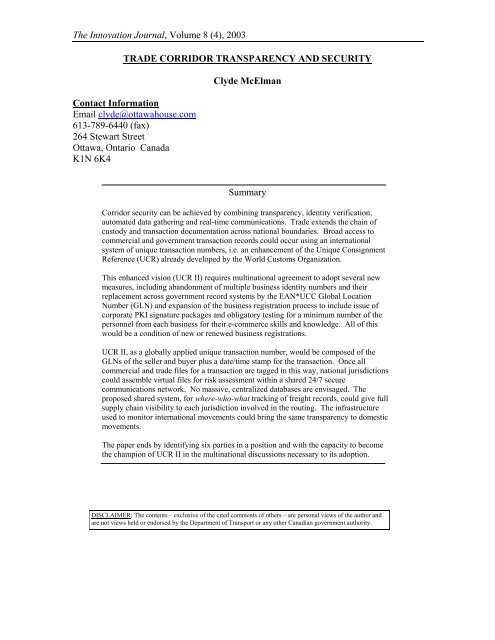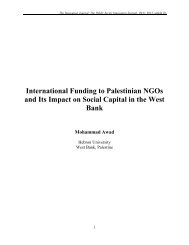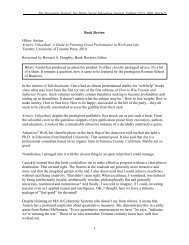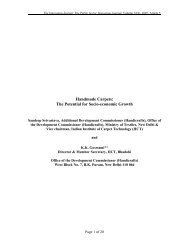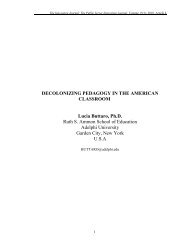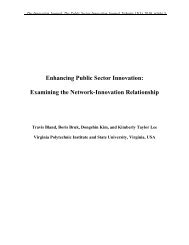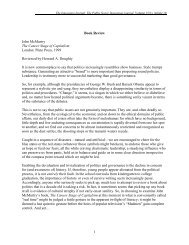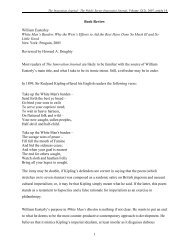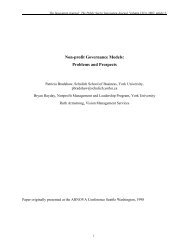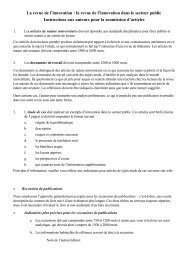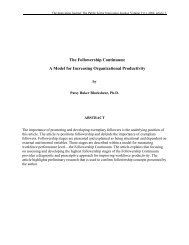Trade Corridor Transparency and Security - The Innovation Journal
Trade Corridor Transparency and Security - The Innovation Journal
Trade Corridor Transparency and Security - The Innovation Journal
Create successful ePaper yourself
Turn your PDF publications into a flip-book with our unique Google optimized e-Paper software.
<strong>The</strong> <strong>Innovation</strong> <strong>Journal</strong>, Volume 8 (4), 2003<br />
TRADE CORRIDOR TRANSPARENCY AND SECURITY<br />
Contact Information<br />
Email clyde@ottawahouse.com<br />
613-789-6440 (fax)<br />
264 Stewart Street<br />
Ottawa, Ontario Canada<br />
K1N 6K4<br />
Clyde McElman<br />
Summary<br />
<strong>Corridor</strong> security can be achieved by combining transparency, identity verification,<br />
automated data gathering <strong>and</strong> real-time communications. <strong>Trade</strong> extends the chain of<br />
custody <strong>and</strong> transaction documentation across national boundaries. Broad access to<br />
commercial <strong>and</strong> government transaction records could occur using an international<br />
system of unique transaction numbers, i.e. an enhancement of the Unique Consignment<br />
Reference (UCR) already developed by the World Customs Organization.<br />
This enhanced vision (UCR II) requires multinational agreement to adopt several new<br />
measures, including ab<strong>and</strong>onment of multiple business identity numbers <strong>and</strong> their<br />
replacement across government record systems by the EAN*UCC Global Location<br />
Number (GLN) <strong>and</strong> expansion of the business registration process to include issue of<br />
corporate PKI signature packages <strong>and</strong> obligatory testing for a minimum number of the<br />
personnel from each business for their e-commerce skills <strong>and</strong> knowledge. All of this<br />
would be a condition of new or renewed business registrations.<br />
UCR II, as a globally applied unique transaction number, would be composed of the<br />
GLNs of the seller <strong>and</strong> buyer plus a date/time stamp for the transaction. Once all<br />
commercial <strong>and</strong> trade files for a transaction are tagged in this way, national jurisdictions<br />
could assemble virtual files for risk assessment within a shared 24/7 secure<br />
communications network. No massive, centralized databases are envisaged. <strong>The</strong><br />
proposed shared system, for where-who-what tracking of freight records, could give full<br />
supply chain visibility to each jurisdiction involved in the routing. <strong>The</strong> infrastructure<br />
used to monitor international movements could bring the same transparency to domestic<br />
movements.<br />
<strong>The</strong> paper ends by identifying six parties in a position <strong>and</strong> with the capacity to become<br />
the champion of UCR II in the multinational discussions necessary to its adoption.<br />
DISCLAIMER: <strong>The</strong> contents – exclusive of the cited comments of others – are personal views of the author <strong>and</strong><br />
are not views held or endorsed by the Department of Transport or any other Canadian government authority.
<strong>The</strong> <strong>Innovation</strong> <strong>Journal</strong>, Volume 8 (4), 2003<br />
Introduction: Nature of the <strong>Trade</strong> System<br />
Customs agencies manage the interface among the world’s economies. <strong>The</strong> daily work<br />
environment comprises a diversity of transactions across trade routes <strong>and</strong> trading partners<br />
drawn from the G8 economies to the least developed. Policies, practices <strong>and</strong> work<br />
instruments must be robust <strong>and</strong> adaptive to function across the full range of these<br />
relationships.<br />
Collaboration <strong>and</strong> harmonization are pursued through the 159-member World Customs<br />
Organization (WCO), under the constraint that each participating customs agency has a<br />
duty to administer according to its own national statutes <strong>and</strong> to protect the best interests<br />
of its home economy. Harmonization is a constant objective. <strong>The</strong> Customs Data Model 1<br />
– one such WCO initiative – seeks to simplify <strong>and</strong> st<strong>and</strong>ardize the electronic information<br />
needed by customs agencies to administer imports <strong>and</strong> exports in a paperless<br />
environment. Work on this project was begun in 1996 by the G7/8 customs agencies of<br />
the UK, USA, Canada, Japan, France, Germany <strong>and</strong> Italy. When completed, the initiative<br />
will give an all-electronic "single-window" to permit trading parties to file the minimum<br />
information required to obtain the customs release of goods entering another country.<br />
<strong>The</strong> WCO also envisages its Customs Data Model as a platform to enable customs-tocustoms<br />
data exchanges. In September-October 2003, the Canadian <strong>and</strong> U.K. customs<br />
agencies implemented a G7/8 trial project that makes available paperless border<br />
clearance for freight movements that do not involve inspection or approval from any<br />
other government agencies. <strong>The</strong> project employs st<strong>and</strong>ardized data sets <strong>and</strong> electronic<br />
messages for its import, export, cargo reporting <strong>and</strong> accounting requirements. Among<br />
the anticipated savings is the ability for traders to re-use export reporting information to<br />
furnish substantial parts of the import reporting requirements of the receiving customs<br />
agency. This is a first opportunity to observe the workings of full paperless operations for<br />
significant movement volumes in a general traffic environment.<br />
Except in crises, change of practices in the customs agency community tends to come in<br />
gradual, measured increments. Consultation must find not only sound <strong>and</strong> commonly<br />
agreed reasons for change, but also must proceed in ways <strong>and</strong> with timing that does not<br />
exceed the diverse capacities of WCO members to achieve the intended results.<br />
Current paper-based supply chain <strong>and</strong> border management systems have high levels of<br />
data transfer ‘friction’ (delays <strong>and</strong> the introduction of errors during successive file<br />
transcriptions) <strong>and</strong> function largely as silos or disconnected isl<strong>and</strong>s of information. Even<br />
though professional communities of brokers, forwarders, express carriers, third party<br />
logistics providers <strong>and</strong> others offer ‘bridging’ <strong>and</strong> ‘expediting’ services between the<br />
isl<strong>and</strong>s, much of their work currently occurs inside proprietary black boxes that exclude<br />
the possibility of general sharing of original entry data with subsequently-involved<br />
parties located further along the supply chain. <strong>The</strong> view from the bridges is perhaps more<br />
extensive than the view from the isl<strong>and</strong>s, but fragmentation persists <strong>and</strong> produces<br />
numerous blind spots.<br />
2
<strong>The</strong> <strong>Innovation</strong> <strong>Journal</strong>, Volume 8 (4), 2003<br />
This fragmentation should not come as a surprise, when the complexity <strong>and</strong> the distant<br />
origins of the trade system <strong>and</strong> customs practices are considered. Each prominent<br />
commercial document, trade practice <strong>and</strong> customs procedure has emerged on a timeline<br />
spanning centuries to meet each era of changing needs <strong>and</strong> to build on the accumulated<br />
foundation of the global trading system. Journey times have shortened from months to<br />
days or hours. Communications have moved from periods of months required to deliver<br />
letter packets to near instantaneous 24/7 networks that deliver data packets. Systems for<br />
currency exchange, credit, security, signature, non-repudiation, quality control <strong>and</strong><br />
numerous other transaction components have undergone generations of innovation,<br />
adaptation, expansion, electrification <strong>and</strong> automation.<br />
One U.S. expert 2 has described trading system dimensions in part as follows: “A typical<br />
trade, in fact, may have as many as 20-25 involved parties – buyers, sellers, inl<strong>and</strong><br />
transporters on both sides of the ocean, ocean <strong>and</strong> other water carriers, middlemen,<br />
financiers, governments <strong>and</strong> others – <strong>and</strong> will generate 30-40 documents <strong>and</strong> some 200<br />
different data elements… …In the US alone, there are an estimated 400,000 importing<br />
<strong>and</strong> exporting companies, 5,000 licensed forwarders <strong>and</strong> customs brokers, perhaps as<br />
many as 40,000 consolidators large <strong>and</strong> small, <strong>and</strong> millions engaged in the<br />
transportation industry. Worldwide, there are at least in theory some 500 ocean carriers<br />
– although probably 10-15 carry 90 percent of cargoes shipped between continents – an<br />
estimated 50-70,000 forwarders <strong>and</strong> tens of thous<strong>and</strong>s more intermediaries, not to<br />
mention several million companies moving goods”. Every economy has produced a bill<br />
of lading, for example, but to date no element of necessity has driven such instruments to<br />
have a common structure or identical uses – not between modes of transport <strong>and</strong> not<br />
between economies. Commercial documents <strong>and</strong> processes in some cases vary in form<br />
between individual enterprises. Customs documentation <strong>and</strong> processes – as already<br />
mentioned – must conform to respective national laws which have little uniformity <strong>and</strong><br />
customs enforcement practices in 159 different domains are informed by these<br />
differences in national law <strong>and</strong> by other national interest considerations. <strong>The</strong>re can be no<br />
expectation of natural synchronicity in all of this.<br />
Bright spots of enlarged coherence do exist within the fabric of significant incoherence.<br />
Useful integration has been achieved in the current air delivery <strong>and</strong> express cargo<br />
systems because of practices such as customer-oriented track <strong>and</strong> trace services <strong>and</strong><br />
extended use of air waybill numbers in the documentation generated among other related<br />
parties. Even here, continued use of multiple identities in other parts of the supply chain<br />
universe (for both the transaction <strong>and</strong> for the related parties) means that the overall result<br />
is anything but an open, transparent system.<br />
<strong>The</strong> two circles in the above diagram indicate the differing domains of interest among the<br />
various parties involved in an international shipment. <strong>The</strong> terms <strong>and</strong> processes of trading<br />
– supplier, buyer, packing list, etc. –are intimately linked with terms from the world of<br />
transport – container, truckload, carrier, etc.; yet they call into play different information<br />
requirements, functions, goals <strong>and</strong> responsibilities. Often the same things or processes<br />
are referred to by different names in the two domains <strong>and</strong> incorporate varying levels of<br />
3
<strong>The</strong> <strong>Innovation</strong> <strong>Journal</strong>, Volume 8 (4), 2003<br />
information detail. Some processes are of interest to both worlds – for example, both<br />
domains contribute information of critical importance to customs agencies. Other<br />
processes are exclusive to the sector <strong>and</strong> operations in one may not affect operations in<br />
the other.<br />
TRADE VS. TRANSPORT 3<br />
<strong>Trade</strong><br />
Transport<br />
Exporter<br />
Importer<br />
Financial<br />
Institutions<br />
Other governmental<br />
Departments<br />
Customs<br />
Freight Forwarder<br />
Other governmental<br />
Departments<br />
Customs Broker<br />
Insurer<br />
Carrier (Marine, Rail,<br />
Truck, Air)<br />
Port Terminal<br />
Operator<br />
Port Authority<br />
Inl<strong>and</strong> Bond<br />
Warehouse<br />
Carriers are not interested in the detailed product information on which the buyer <strong>and</strong><br />
seller base their transaction. Carriers seek only information that directly affects their<br />
business – general identifying descriptions of the product <strong>and</strong> shipper, plus the factors<br />
that affect stowage <strong>and</strong> h<strong>and</strong>ling, i.e. how heavy, what dimensions, how much, where, to<br />
whom. As long as the goods arrive at the right time, at the right place <strong>and</strong> in good<br />
condition for that carrier’s portion of the journey, it does not matter that they went to a<br />
consolidation warehouse, were transferred numerous times to different parties <strong>and</strong><br />
carriers.<br />
Customs, in its dual role of security risk assessor <strong>and</strong> excise <strong>and</strong> duty collector is<br />
interested in the buyer, seller <strong>and</strong> chain of custody aspects <strong>and</strong> also in the valuation,<br />
quantity <strong>and</strong> classification of the goods. Until recently, the information known to<br />
customs would be the last port of lading (or terminal of lading) of the goods, the current<br />
shipper, the carrier <strong>and</strong> the destination. Going forward, customs agencies are turning<br />
their attention to increasing levels of intelligence that support more sophisticated risks<br />
assessments <strong>and</strong> exp<strong>and</strong> transparency across the entire supply chain.<br />
Nature of the <strong>Security</strong> Challenge<br />
All of this has significant implications for the current efforts to enhance transportation<br />
security, which must function in a globally interconnected web of services, yet eventually<br />
must resolve all potential blind spots.<br />
4
<strong>The</strong> <strong>Innovation</strong> <strong>Journal</strong>, Volume 8 (4), 2003<br />
In transportation, the frame of reference is a transaction – meaning that the location<br />
aspect of risk is a shifting continuum within a “lane” or a “corridor”. <strong>Security</strong> in<br />
transportation must calculate the where-who-what equation in order to identify <strong>and</strong><br />
manage overall risks. Each element must be known sufficiently to get the job done.<br />
Information gaps <strong>and</strong> delays lead to blind spots.<br />
1. Location: What is the route? Where is the movement now <strong>and</strong> where is it headed?<br />
2. Identity (Persons): Who is involved at each stage? Do they have a relevant history?<br />
3. Identity (Things): What kinds of goods, assets <strong>and</strong> support systems are involved?<br />
What ones are parts of this transaction? Do they have a relevant history?<br />
A forward-looking border management process will align the interests of commerce with<br />
those of security. Freightdesk Chairman & CEO Rob Quartel has called for a system of<br />
“virtual” entry profiles, based on contents, involved parties, financial information <strong>and</strong> all<br />
records of mode <strong>and</strong> path of transit. His proposals focus on international container flows,<br />
but the required information <strong>and</strong> business process infrastructure could serve equally well<br />
for the inl<strong>and</strong> legs of cross-border shipments as well as to movements that occur entirely<br />
within domestic freight corridors of different economies. Temporary on-screen<br />
compilations of combined data sets, assembled “on the fly” from commercial documents<br />
together with government law enforcement <strong>and</strong> national security information, could<br />
create the overall profile that is subjected to various types of risk analysis at critical<br />
points of the journey. Shipments that span several economies will present varying risk<br />
profiles in each segment of the journey. St<strong>and</strong>still periods, i.e. “dwell times”, within a<br />
corridor will vary in number, duration <strong>and</strong> location <strong>and</strong> will alter potential risks,<br />
whether from intrusion, substitution, loss, accidents, theft, etc.<br />
A multilateral system for risk evaluation could ensure for every shipment that each<br />
national jurisdiction could have the means to consider <strong>and</strong> act upon risks to its citizens,<br />
property <strong>and</strong> territory. Meeting this objective requires new means to monitor individual<br />
transportation movements as the journey unfolds in a world that currently has only<br />
limited capacity to provide such corridor transparency.<br />
WCO Initiative – Unique Consignment Reference<br />
One new data element – the unique consignment reference 4 (UCR) – was devised by the<br />
WCO in the late 1990s as a key feature under the Customs Data Model. It gives a<br />
traceable identifying number for an international movement of goods, both to monitor the<br />
movement during its life, <strong>and</strong> to audit the movement after it has been completed,<br />
i.e. "Like an electronic staple designed for e-commerce, a UCR binds information<br />
together, all the bits of data about a trade transaction, from initial order <strong>and</strong> consignment<br />
of goods by a supplier, to the movement of those goods <strong>and</strong> arrival at the border, through<br />
to their final delivery to the importer".<br />
In the original development plan for UCR, the WCO proposed to test the two types of<br />
numbering systems; the first requiring common worldwide adoption of a new business<br />
5
<strong>The</strong> <strong>Innovation</strong> <strong>Journal</strong>, Volume 8 (4), 2003<br />
practice <strong>and</strong> the second, combining an existing, nationally-applied corporate identifier for<br />
the shipper with a shipper-provided identifier for the goods:<br />
1. Globally Applied Unique Transaction Number: This approach would have<br />
obliged all parties to an international goods movement to adopt a single, globally<br />
applied reference number in all parts of each transaction, so that the audit trail<br />
between all commercial <strong>and</strong> trade documents generated by any of the parties<br />
would reside in a common number applied to each document. Under this<br />
proposal, paper-based <strong>and</strong> automated processes required modification to make<br />
room for this new identifier, i.e. the classic formulation of short-term pain for<br />
long-term gain. Existence of a relationship between documents is easily verified<br />
by reference to a single data point, so information management under this<br />
structure is amenable both to relational database techniques <strong>and</strong> to the more<br />
Internet-friendly architecture associated with distributed processing.<br />
2. Relational Database Links: <strong>The</strong> second approach obliges the seller of goods to<br />
generate a number for each international transaction containing an officially<br />
recognized national company identifier e.g. Customs, VAT, DUNS, EAN ID<br />
number, <strong>and</strong> an internally applied company reference to the goods covered by the<br />
transaction, e.g. purchase order, invoice number, etc. <strong>The</strong> resultant unique<br />
transaction number then is linked to other identifiers, i.e. broker /carrier<br />
commercial reference numbers, as additional parties join the original transaction.<br />
This growing table of relationships or joins between the various data files also<br />
must be preserved through any consignment splitting <strong>and</strong> consolidation for<br />
transportation purposes. <strong>The</strong> implied mechanism for accessing the audit trail back<br />
to the seller’s universal reference is through relational database techniques.<br />
<strong>The</strong> attraction for buyers, sellers, inl<strong>and</strong> transporters, ocean <strong>and</strong> other water<br />
carriers, middlemen <strong>and</strong> financiers is that the relational database permits the least<br />
disturbance on their business practices <strong>and</strong> legacy record systems. <strong>The</strong> downside<br />
is that this strategy masks the vast differences housed in the legacy structures<br />
within <strong>and</strong> between the 159 WCO jurisdictions that are responsible for processing<br />
more than 95 % of all international trade.<br />
When a relational database is queried, the target data must first be traced <strong>and</strong> then<br />
returned through a series of record joins that define the relationship. With sufficient time<br />
<strong>and</strong> resources, it may be possible to construct <strong>and</strong> implement a relationship-crunching<br />
engine that is robust <strong>and</strong> agile enough to h<strong>and</strong>le this diversity. Even so, it is inevitable<br />
that cases will arise – scattered unevenly through the present legacy structures – where<br />
some part of national record systems will not make the technical compatibility ‘cut’ in<br />
order for the relational database approach to work. Even if whole border management<br />
systems do not fall out during a conversion process, it is inevitable that a lack of technical<br />
compatibility or capacity will arbitrarily consign some industry sectors or companies to<br />
the sidelines until they can comply. <strong>The</strong>se ‘drop-outs’ are unlikely to go quietly.<br />
6
<strong>The</strong> <strong>Innovation</strong> <strong>Journal</strong>, Volume 8 (4), 2003<br />
In the five years before September 11, 2001 (9/11), discussions with the trade exposed<br />
customs agencies to considerable ‘push back’ against the short-term pain proposition. It<br />
was considered a prohibitive expense with no early paybacks to dem<strong>and</strong> that the paperbased<br />
<strong>and</strong> automated systems maintained by different parts of the world trade system be<br />
modified to add a new transaction identification number. By June 1999, the relational<br />
database approach <strong>and</strong> its minimal disturbance of legacy systems emerged from the<br />
review process as the preferred approach. No timetable emerged, however, by which the<br />
Customs Data Model or the relational database version of the UCR was to become a<br />
st<strong>and</strong>ard component of the global customs clearance apparatus.<br />
WCO Gradualist Strategy<br />
Even with the dramatic changes to world trade practices already put in motion since 9/11,<br />
the WCO is yet to adopt a firm timetable for m<strong>and</strong>atory changes. Early in 2003, the<br />
WCO enunciated a gradualist strategy of guidelines for co-operative arrangements<br />
between Customs agencies <strong>and</strong> private industry, which WCO documentation 5<br />
summarizes as follows:<br />
1. Use of the “Authorised <strong>Trade</strong>r 6 ” concept within the supply chain;<br />
2. Use of the Unique Consignment Reference (UCR);<br />
3. Provision of security for the entire supply chain, including authorised trader<br />
premises;<br />
4. Expansion of information <strong>and</strong> intelligence sources <strong>and</strong> capabilities, including the<br />
earlier collection <strong>and</strong> provision of information <strong>and</strong> intelligence gathered from all<br />
possible sources;<br />
5. Reliance on voluntary co-operation with the international business community,<br />
retaining the option for legislation <strong>and</strong> m<strong>and</strong>atory procedures, <strong>and</strong> mutual<br />
recognition of the secure assurance procedures in other countries; <strong>and</strong><br />
6. Building on the existing initiatives such as BASC 7 <strong>and</strong> C-TPAT.<br />
U.S. <strong>Security</strong> Imperatives And <strong>The</strong>ir Costs<br />
Against this WCO gradualist strategy, the circle of affected parties continues to exp<strong>and</strong><br />
under the U.S. post-9/11 border management protocols, e.g. the Container <strong>Security</strong><br />
Initiative (CSI), the Customs-<strong>Trade</strong> Partnership Against Terrorism (C-TPAT) <strong>and</strong> Free<br />
And Secure <strong>Trade</strong> (FAST). Some of these measures are said by the U.S. to be<br />
‘voluntary’, but only in the sense that businesses from other economies must comply with<br />
these dem<strong>and</strong>s if they wish to continue trade with the U.S. under the best available terms.<br />
Pushing U.S. borders outward under these programs requires a ‘voluntary’ worldwide reengineering<br />
of business processes, the installation of a significant subset of available<br />
paperless trading capabilities <strong>and</strong> major public <strong>and</strong> private expenditures by foreign<br />
parties. In a July 2003 report entitled <strong>Security</strong> In Maritime Transport: Risk Factors And<br />
Economic Impact 8 the OECD Maritime Transport Committee places worldwide costs in<br />
7
<strong>The</strong> <strong>Innovation</strong> <strong>Journal</strong>, Volume 8 (4), 2003<br />
excess of $60 billion (US) for any marine system shutdown in response to a coordinated<br />
terrorist attack. Against this risk, the report estimates global maritime sector costs of<br />
current system changes at $1.3 billion in the first year, with recurring annual costs of<br />
about $700 million. In addition to the costs imposed by the U.S. programs already cited,<br />
the OECD report covers a new package security measures that are now m<strong>and</strong>atory on all<br />
signatories of the Safety of Life at Sea (SOLAS) Convention – amended by a new<br />
Chapter X1-2 that solely addresses ship security – <strong>and</strong> by a new, 2-part, International<br />
Ship <strong>and</strong> Port Facility <strong>Security</strong> Code (ISPS) Code.<br />
<strong>The</strong> layered nature of the voluntary <strong>and</strong> m<strong>and</strong>atory strategies is portrayed in the report as<br />
follows:<br />
<strong>The</strong> OECD report also contains a reminder that “many of the measures proposed have<br />
distinct benefits that are not related to their anti-terrorism task. <strong>The</strong>se benefits result<br />
from reduced delays, faster processing times, better asset control, decreased payroll (due<br />
to IT improvements), fewer losses due to theft, decreased insurance costs, etc. <strong>The</strong>se<br />
savings can be significant, <strong>and</strong> can serve to counter-balance the increase in security<br />
costs”<br />
<strong>The</strong> magnitude <strong>and</strong> swiftness of this portfolio of measures demonstrate that the WCO<br />
gradualism strategy is seriously out of step with the ‘comply-or-wait’ world now being<br />
driven by unilateral U.S. security policy choices. Neither can it be imagined that the list<br />
of eventual changes is fully formed – whether in the marine world or in other parts of the<br />
global trading system. As reviews <strong>and</strong> audits reveal further blind spots in end-to-end<br />
logistics chains, U.S. authorities will enlarge their dem<strong>and</strong>s until a minimum acceptable<br />
version of trade corridor transparency is reached. Doing less only jeopardizes the large<br />
8
<strong>The</strong> <strong>Innovation</strong> <strong>Journal</strong>, Volume 8 (4), 2003<br />
re-engineering investments already completed or authorized <strong>and</strong> U.S. authorities are<br />
unlikely to opt for a security framework that figuratively sends astronauts only halfway to<br />
the moon.<br />
<strong>The</strong> communities of trade practitioners who pushed aside the UCR option of a globally<br />
applied unique transaction number wanted to minimize disturbance to their legacy<br />
investments. <strong>The</strong> same parties are now scrambling to design, finance <strong>and</strong> deploy far<br />
more dem<strong>and</strong>ing changes to their operations <strong>and</strong> records systems. Parties who operate in<br />
trade lanes into <strong>and</strong> out of the U.S. now must move to meet the paperless<br />
communications requirements dem<strong>and</strong>ed by the U.S. Bureau of Customs & Border<br />
Protection (CBP) <strong>and</strong> other U.S. agencies. <strong>The</strong> trade must either begin continuous<br />
conversion of legacy data through specialists in data capture <strong>and</strong> manipulation services or<br />
ab<strong>and</strong>on paper-based legacy systems to automated replacements. This short-term pain is<br />
evolving with extraordinary rapidity, with a minimum of consultation <strong>and</strong> with real risks<br />
of inadequate design st<strong>and</strong>ards for the long-term, which, like the Y2K shortcut, may<br />
require costly downstream rationalization <strong>and</strong> repair.<br />
Nothing in these worldwide changes is intended to overcome cobbled-together nature of<br />
the relational database model now being pursued under the UCR initiative. Holding to<br />
the priority of legacy systems over the adoption of a st<strong>and</strong>ards-based response only<br />
encourages continued evolution of legacy systems along divergent tracks. A relational<br />
database strategy – while it remains at a local or national scale – may be able to mask<br />
current incompatibilities among the multiplicity of underlying structures <strong>and</strong> practices.<br />
And a voluntary approach to implementation can forestall any early confrontations over<br />
global incompatibilities or non-compliance. Until these strategic issues are resolved, they<br />
will only exp<strong>and</strong> the level of systemic risks in the global trade apparatus <strong>and</strong> maintain<br />
blind spots within transactional chains of custody that may one day be exploited by<br />
parties with malicious intent.<br />
<strong>The</strong> durability <strong>and</strong> scalability of the central junction box of a future paperless system has<br />
to be considered against the background of the daily volumes of trade <strong>and</strong> transportation<br />
shipments, the evolution of corporate inventory <strong>and</strong> just-in-time practices <strong>and</strong> the<br />
changing requirements in real-time track <strong>and</strong> trace capabilities. <strong>The</strong>se practices imply<br />
high volumes of repeated ID, location <strong>and</strong> shipment condition queries. <strong>The</strong> daily number<br />
of hits, queries <strong>and</strong> new transactions will continue to grow. This is a major pressure<br />
vector, where the target, recipient <strong>and</strong> contents of every message must parsed repeatedly<br />
by a single, centralized relationship-crunching engine. Another disconnect vector will<br />
emerge as vendor capture further accentuates the black box differences between legacy<br />
systems, during the migration from paper transactions to the paperless capabilities that<br />
will be required under each new U.S. specification of its security requirements for trade.<br />
<strong>The</strong> UCR relational database model is likely to fracture then break under the stresses of<br />
these <strong>and</strong> other centripetal vectors, together with the expediencies encouraged under the<br />
rapid implementation dem<strong>and</strong>ed by U.S. policies. Failure of the customs clearance<br />
system of one economy has the same consequences as the disruptions of a terrorist event<br />
9
<strong>The</strong> <strong>Innovation</strong> <strong>Journal</strong>, Volume 8 (4), 2003<br />
or work stoppages due to a strike, i.e. it severs the connections between a particular<br />
economy <strong>and</strong> the rest of the world trading system. Should the failure occur in a poorly<br />
designed or under built central junction box, the impacts are far more widespread, the<br />
repair could not happen quickly <strong>and</strong> the investments-to-date by all parties are placed in<br />
equal jeopardy.<br />
Timely To Consider Altering Course – UCR II<br />
<strong>The</strong>re is another important change factor since the UCR design began to move along its<br />
current path. Considerable work on globally unique numbering systems has now been<br />
done in the private sector. Work by the EAN*UCC offers a prominent example. <strong>The</strong>se<br />
two organizations began as separate industry councils devoted to industry st<strong>and</strong>ardization<br />
<strong>and</strong> best practices <strong>and</strong> are best known as the global managers of the international barcode<br />
system. EAN*UCC is pursuing voluntary industry adoption of multiple, mutually<br />
supporting numbering <strong>and</strong> identity systems, i.e. for goods, locations, corporations,<br />
h<strong>and</strong>ling equipment, containment systems <strong>and</strong> transport vehicles. One of these is the<br />
global location number (GLN) 9 , which offers unambiguous <strong>and</strong> efficient identification<br />
around the world of corporations <strong>and</strong> their operating locations.<br />
At the very least, the alternative vision of the UCR under a globally applied unique<br />
transaction number needs to be revisited to ask whether it offers a better path to follow in<br />
today’s greatly changed circumstances.<br />
This document supports the idea that a modified UCR (UCR II) should be embraced in<br />
order to take full advantage of convergence now occurring between the Internet, goods<br />
tracking <strong>and</strong> E-commerce environments.<br />
<strong>The</strong>re are five pillars of change that could usefully appear in the UCR II vision.<br />
1. A globally applied unique transaction number ideally applied in all domestic <strong>and</strong><br />
international business-to-business transactions (B2B).<br />
2. International conversion <strong>and</strong> augmentation of business registration processes to<br />
include three features<br />
(a) ab<strong>and</strong>onment of multiple business identity numbers <strong>and</strong> their replacement across<br />
government record systems by the EAN*UCC Global Location Number (GLN);<br />
(b) new <strong>and</strong> existing business entities receive an appropriate PKI authentication<br />
toolkit as part of their initial registration or renewal, with renewal cycles<br />
temporarily shortened as part of a transition period; <strong>and</strong><br />
(c) obligatory testing for a minimum number of the personnel from each business for<br />
their e-commerce skills <strong>and</strong> knowledge (GLNs, PKI <strong>and</strong> related skills) as a<br />
condition of new or renewed business registrations. This would compare to the<br />
skill <strong>and</strong> knowledge testing in driver licensing.<br />
3. Establishing transaction uniqueness from a UCR II composed of the GLNs of the<br />
seller <strong>and</strong> buyer plus a date/time stamp for the transaction.<br />
10
<strong>The</strong> <strong>Innovation</strong> <strong>Journal</strong>, Volume 8 (4), 2003<br />
4. Giving the UCR II identifier a special Internet “presence”, i.e. a cross between an<br />
always-on IP address <strong>and</strong> the “presence awareness” features of instant messaging<br />
addresses.<br />
5. Cooperative installation of an international secure “spine” network to contain the<br />
communications that locate – <strong>and</strong> can examine inside a virtual file – all messages <strong>and</strong><br />
other commercial documents that bear a common UCR II transaction identifier,<br />
i.e. the Internet of commercial <strong>and</strong> trade documentation.<br />
UCR II imagines that it would be possible to secure cooperation among governments<br />
who form a sufficient critical mass so that these measures in due course could become<br />
global. It imagines that participating governments <strong>and</strong> private holders of key intellectual<br />
properties could find the basis for the necessary private-public partnerships. <strong>The</strong> goal<br />
imagines that billions in private <strong>and</strong> public investments could be agreed <strong>and</strong> coordinated<br />
in a comparatively short time period. It imagines that U.S. unilateral requirements for<br />
heightened security could merge successfully with a multilateral re-engineering of<br />
business processes intended in part to satisfy other public <strong>and</strong> private objectives. And<br />
finally, the UCR II vision imagines that public <strong>and</strong> private participants could devise,<br />
reach international agreement on <strong>and</strong> deploy the layered <strong>and</strong> nested set of<br />
communications, security <strong>and</strong> accountability protocols required for a secure “spine”<br />
network.<br />
<strong>The</strong> first inclination will be to label this UCR II vision as an impossible fantasy. Yet is<br />
this really the case? How much is already under way or will have to be launched in any<br />
case in response commercial need <strong>and</strong> to U.S. imperatives? <strong>The</strong> UCR II vision contains<br />
some elements of invention <strong>and</strong> transformation, but mainly it provides a holistic insight<br />
that integrates <strong>and</strong> harmonizes the energies of current re-engineering <strong>and</strong> investment<br />
decisions – a proverbial joining of the dots already present in the environment. <strong>The</strong><br />
11 factors reviewed below indicate that substantial portions of the 5 pillars for UCR II<br />
already exist or are coming into being.<br />
1. Corporate identity: Current governmental practice within national public record<br />
systems is to assign multiple identifiers to any resident corporation. Multiple<br />
corporate pseudonyms are anathema to the good operation of automated,<br />
instantaneous, global transaction systems, i.e. the much forecast but yet-to-emerge e-<br />
commerce world. Such ambiguity is significantly out of step in an environment that<br />
is moving rapidly toward unique identifiers on all manufactured items (to create an<br />
Internet of things) <strong>and</strong> dem<strong>and</strong>s that the uniqueness <strong>and</strong> risk factors of personal<br />
identities be supported by regular criminal background checks, substance abuse tests<br />
<strong>and</strong> by photographs, fingerprints <strong>and</strong> other biometric markers. Unlike C-TPAT, CSI<br />
<strong>and</strong> FAST, unification of corporate identities would place the same 'burden of change'<br />
on the US government <strong>and</strong> US companies as is now imposed on the rest of the world.<br />
2. Resources: <strong>The</strong> decisions of BCP, a single US agency, to meet comparatively narrow<br />
goals have triggered a first round of re-engineering costs in the global trade system<br />
that is likely to exceed $10-$12 billion over the next decade. Further BCP dem<strong>and</strong>s<br />
11
<strong>The</strong> <strong>Innovation</strong> <strong>Journal</strong>, Volume 8 (4), 2003<br />
are likely to involve a comparable global sum of that size in the same decade, i.e. an<br />
aggregate of perhaps $20 billion – once these are defined, particularly in regard to<br />
truck mode communications/tracking capacities <strong>and</strong> for verifiable worker<br />
identification <strong>and</strong> history checks along entire domestic <strong>and</strong> international chains of<br />
custody. Changes on this scale need careful discussion among the affected parties to<br />
verify that the right outcomes are being purchased.<br />
3. Technological expediency: <strong>The</strong> Y2K problem underscored how expense <strong>and</strong><br />
disruption to clean up once technological expediency imposes limited vision <strong>and</strong> fails<br />
to consider the long-run consequences of global scale <strong>and</strong> integration. Similarly,<br />
various contagion problems (BSE, SARS, West Nile virus, etc.) also are<br />
demonstrating that technologically furnished global information has an important<br />
role in modern societies outside the management of terrorist risks.<br />
4. Skills <strong>and</strong> knowledge testing: Drivers, pilots, mariners, locomotive engineers,<br />
stationary engineers, lab technicians, doctors, nurses, lawyers, dentists <strong>and</strong> many<br />
others are challenged to demonstrate basic knowledge <strong>and</strong> competencies before they<br />
are permitted to pursue complex activities, where lack of due care <strong>and</strong> competence<br />
might inflict great harm on individuals or the public at large. Business entities by<br />
their policies <strong>and</strong> practices already demonstrate large capacities to inflict harm<br />
(thalidomide, Tylenol, tobacco, BSE, Enron, etc.). At a more basic level, however,<br />
the e-commerce world can only emerge when the public <strong>and</strong> business partners can be<br />
confident that business representatives whom they encounter have the capability to<br />
consistently execute secure, competent transactions. Allowing entry by untutored<br />
amateurs <strong>and</strong> sourcing skills primarily through on-the-job training is a dubious<br />
approach this confidence building. More is required.<br />
5. Distributed processing: <strong>The</strong> globally applied unique transaction number enables<br />
transformation from a paper-based ‘push’ system for inspection of a fully assembled<br />
paper file at the physical border to a distributed architecture, Internet-based ‘pull’<br />
system, i.e. one where processes are designed to pull the original entries of critical<br />
transaction information to each place <strong>and</strong> time where they are needed to continue the<br />
movement of goods within the supply chain. This design captures the redundancy,<br />
resilience <strong>and</strong> scalability features normally present in such distributed architectures.<br />
Bearing the short-term pain to establish this capacity will locate border clearance<br />
decisions in the first real-time, end-to-end view of trade-based supply chains.<br />
6. <strong>Corridor</strong> transparency: <strong>The</strong> infrastructure <strong>and</strong> business processes needed for border<br />
management will enable domestic corridors of supply chains to have the same level<br />
of transparency. It becomes practical under this model to move the security system<br />
from a strategy of an 'enlarged perimeter' to a strategy of corridor transparency <strong>and</strong> to<br />
have universal tracking from the factory door to the final customer. UCR II would<br />
merge with <strong>and</strong> be greatly strengthened by the ‘Internet of things’ now starting to be<br />
deployed through RFID 10 tagging <strong>and</strong> real-time location reporting systems for<br />
manufacturing <strong>and</strong> retail<br />
12
<strong>The</strong> <strong>Innovation</strong> <strong>Journal</strong>, Volume 8 (4), 2003<br />
7. Private-public partnerships: Governments generally have a strong aversion to<br />
entering technical areas in a manner that could disrupt competitive supply – even<br />
where government has an evident role as a model user. Private-public<br />
partnership (PPP) may be the only viable institutional setting to permit government<br />
activism. Public authority under its business-numbering role is in a position in a brief<br />
time to move GLNs <strong>and</strong> PKIs from low market acceptance to a universal element of<br />
B2B sector transactions. Negotiation of global PPPs for the assignment of GLNs <strong>and</strong><br />
PKIs as part of business registration also could require or award points for a<br />
"developing countries special measures package" <strong>and</strong>/or an “SME special measures<br />
package”. <strong>The</strong> enabling mechanisms of electronic commerce, e.g. GLNs, PKIs,<br />
secure channels <strong>and</strong> so forth, appear to be trapped at low points of the acceptance<br />
curve 11 for new technologies <strong>The</strong>se are areas where investment uncertainty is likely to<br />
remain prohibitively high unless the public <strong>and</strong> private sectors move forward in<br />
unison. Without a PPP initiative it is unclear when <strong>and</strong> how a move to broad<br />
acceptance will be reached.<br />
8. Internet business model: Once platforms like GLN <strong>and</strong> PKI are in place, the private<br />
sector can be expected to make steady progress in marketing ‘stack on’ value through<br />
existing products <strong>and</strong> through new innovations. <strong>The</strong> supplier incentive to ‘give away’<br />
GLNs or PKI signature toolkits is to gain an edge in critical distribution channels. 12<br />
This was evident during the ‘browser wars’ period of early Internet development <strong>and</strong><br />
in the business model for the satellite-based GPS system, where commercial valueadded<br />
services are now stacked on top of the ‘free’ public signal.<br />
9. Sovereignty: UCR II enables access by any participating government – should they<br />
wish it – to the same risk factor profiles as will be available to US authorities. This<br />
gives a genuine aspect of mutual defence against terrorist acts. <strong>The</strong> UCR II vision<br />
also incorporates a broad distribution of similar burdens of limited duration, will<br />
generate substantial offsetting benefits for the parties in other areas of their business<br />
that are not trade- <strong>and</strong> customs-related <strong>and</strong> avoids the fact or appearance of<br />
unreasonable advantages flowing largely from asymmetrical power relationships.<br />
<strong>The</strong> perception of threats to sovereignty also should be reduced in a setting where<br />
pain is to be shared by all.<br />
10. St<strong>and</strong>ards: Six international st<strong>and</strong>ards organizations have work under way in multiple<br />
domains 13 related to transportation logistics, communications, security, border<br />
management <strong>and</strong> electronic commerce: the World Customs Organization, the<br />
International Electrotechnical Commission, the International St<strong>and</strong>ards Organization,<br />
the United Nations Economic Commission for Europe, the International<br />
Telecommunications Union <strong>and</strong> the International Maritime Organization. In order to<br />
mitigate the potential for overlap <strong>and</strong> conflict among these many related work<br />
domains there are multiple MOU arrangements <strong>and</strong> steering committee machinery<br />
maintain coordination toward common goals. <strong>The</strong> UCR II vision depends on<br />
coordinated international action <strong>and</strong> these st<strong>and</strong>ards organizations furnish an<br />
13
<strong>The</strong> <strong>Innovation</strong> <strong>Journal</strong>, Volume 8 (4), 2003<br />
immense reservoir knowledge, expertise <strong>and</strong> good will on which the parties may<br />
draw.<br />
11. Spine network: In the UCR II vision, the spine provides the global communications<br />
environment for a new Internet of commercial <strong>and</strong> trade documentation. <strong>The</strong> scope<br />
of the proposed spine facility is illustrated below. Using a distributed processing<br />
architecture, the “spine” would provide border management <strong>and</strong> security authorities<br />
of participating economies with dynamic access to every supply chain at any stage of<br />
transaction completion <strong>and</strong> permit on-the-fly merger of this intelligence with relevant<br />
information from government files in order to do comprehensive risk analysis. Direct<br />
accountability for the quality, timeliness <strong>and</strong> authentication of data inputs will fall on<br />
each participating supplier for their own inputs, rather a consolidation by one or two<br />
overburdened parties before the file is submitted to public authorities.<br />
RISK ASSESSMENT<br />
• Where-who-what equation is determined<br />
sufficiently to manage overall risks.<br />
IDENTITY/ROUTE<br />
• Unique, encrypted tag (UCR II) assigned to<br />
each movement <strong>and</strong> affixed to each “profile”<br />
record developed by any party at any stage of<br />
the transaction.<br />
• Functions like a transponder or an IP address<br />
for each primary buy-sell transaction.<br />
• UCR II ID also affixed to all other supply chain<br />
records that bring in subcontracts under the<br />
primary buy-sell transaction.<br />
• UCR II switched to “inactive” on these records<br />
once the trip is completed, but these inactive<br />
“histories” can be accessed via data mining<br />
across the spine as part of the where-who-what<br />
risk assessment for a new active trip.<br />
NOTICE<br />
• Notice of the route <strong>and</strong> the UCR II number sent<br />
to each jurisdiction included in the route.<br />
SPINE/UCR II<br />
• Parties maintain secure 24/7 access to UCR II<br />
records.<br />
• Record system integrity regularly verified<br />
through new ISO st<strong>and</strong>ard for security<br />
practices.<br />
Finding A Champion<br />
<strong>The</strong> foregoing discussion deals with the ‘what’ <strong>and</strong> the ‘why’ of the UCR II vision. In a<br />
context where multinational or global action is the preferred result, the final critical issue<br />
14
<strong>The</strong> <strong>Innovation</strong> <strong>Journal</strong>, Volume 8 (4), 2003<br />
is to identify the ‘who’. Whatever the merits of the vision, no progress is possible on this<br />
scale unless a credible champion can be found. So, who could carry it off?<br />
<strong>The</strong>re are a number of c<strong>and</strong>idates:<br />
1. U.S. Bureau of Customs & Border Protection: CBP holds a critical leverage point<br />
within the Homel<strong>and</strong> <strong>Security</strong> apparatus. If it identified the 5 pillars of UCR II as its<br />
preferred architecture for moving forward, there is a good likelihood that the<br />
Department of Homel<strong>and</strong> <strong>Security</strong> could be enlisted into the concept <strong>and</strong> a parallel<br />
likelihood that members of Congress would sponsor supportive legislative proposals.<br />
2. Ridge-Manley: UCR II would offer the Ridge-Manley bilateral process a choice<br />
between incremental upgrading of the Smart Border Accord <strong>and</strong> its 30-point action<br />
plan <strong>and</strong> its replacement by an integrated vision under the 5 pillars of UCR II. On its<br />
face, bilateral implementation of the 5 pillars is a sub-optimal choice, but it could be<br />
presented as a proof-of-concept initiative in the bilateral setting, with every intention<br />
of its expansion to other trading partners after a trial period.<br />
3. World Customs Organization: This is a natural progression from the present<br />
voluntary UCR model within the WCO Customs Data Model. Inclusion of a<br />
"developing countries special measures package" <strong>and</strong>/or an “SME special measures<br />
package” – as one of the competitive evaluation features in the run-up to the<br />
formation of a PPP – could help include a good number of less developed economies<br />
within a WCO consensus to proceed under the UCR II vision.<br />
4. A Global E-business Consortium: EAN*UCC <strong>and</strong> the leading vendors of PKI<br />
products would have an attractive opportunity to transform their modest customer<br />
bases for the GLN <strong>and</strong> PKI products into near global distribution channels. A private<br />
sector-led initiative <strong>and</strong> the effective transformation of significant intellectual<br />
properties into public goods would be an attractive feature for governments.<br />
5. APEC: Regional sponsorship of an integrated vision under the 5 pillars of UCR II is a<br />
sub-optimal choice on its face. It could be presented as a proof-of-concept initiative<br />
in this regional setting, with every intention of its expansion to other trading partners<br />
after a trial period. Inclusion of a "developing countries special measures package"<br />
<strong>and</strong>/or an “SME special measures package” as one of the competitive evaluation<br />
features could help include a good number of APECs less developed economies<br />
within a consensus to proceed under the UCR II vision.<br />
6. Canada Customs & Revenue Agency: Unilateral sponsorship of the 5 pillars of<br />
UCR II is a sub-optimal choice on its face. It could be presented as a proof-ofconcept<br />
initiative <strong>and</strong> pursued for the early adopter savings <strong>and</strong> synergies that would<br />
accrue to Canadian firms <strong>and</strong> increase their competitive advantages in the global<br />
trading environment. In demonstrating the capture of these first order benefits by<br />
Canadian businesses, leverage would be generated to enlist the early participation of<br />
other international partners.<br />
15
<strong>The</strong> <strong>Innovation</strong> <strong>Journal</strong>, Volume 8 (4), 2003<br />
Conclusion<br />
<strong>Trade</strong> corridor transparency <strong>and</strong> security can be achieved provided business processes are<br />
re-engineered, information management <strong>and</strong> communications strategies are optimized to<br />
exploit distributed processing in a shared global network, parties reach international<br />
agreement on a layered <strong>and</strong> nested set of communications, security <strong>and</strong> accountability<br />
protocols required for a secure “spine” network <strong>and</strong> necessary private <strong>and</strong> public<br />
investments are made in a portfolio of technologies to support the whole effort.<br />
<strong>The</strong> U.S. through an escalating series of unilateral dem<strong>and</strong>s placed its principal trading<br />
partners can attempt such a goal. Alternatively, it can be sought through formal<br />
international agreements or other multilateral mechanisms. Multilateral solutions would<br />
distribute accountabilities <strong>and</strong> incorporate a capability to identify <strong>and</strong> manage risks to the<br />
citizens, property <strong>and</strong> territory of each participating economy.<br />
<strong>The</strong> measures are so extensive that international willingness to bear the related burdens<br />
<strong>and</strong> risks may only be attainable where economic <strong>and</strong> social gains are attended to as well<br />
as improved security outcomes.<br />
<strong>The</strong> changed business processes that comprise the five pillars of the UCR II proposal are<br />
meant to ensure rapid emergence of electronic commerce as a predominant environment<br />
for global business-to-business commercial relations.<br />
<strong>The</strong> critical issue in all of this is not simply to broadcast a new vision. Rather, it is to find<br />
the single champion or to form a core of co-adventurers who will persist long enough, far<br />
enough <strong>and</strong> with enough flexibility <strong>and</strong> pragmatism to deliver a working result of the<br />
vision.<br />
About <strong>The</strong> Author<br />
Clyde McElman is Senior Advisor, Logistics & E-commerce, in the Strategic Policy<br />
Directorate of the Department of Transport in the Government of Canada. His reputation<br />
with colleagues is that of an outside-the-box contributor in responding to policy<br />
challenges. In 26 years as a manager with the Policy Group he has served in Director<br />
level policy positions related to railway <strong>and</strong> grain transportation <strong>and</strong> on several task<br />
groups to pursue legislative changes (Canada Marine Act, Canada Transportation Act,<br />
Western Grain Transportation Act). Earlier, he served with the Council of Maritime<br />
Premiers in Halifax <strong>and</strong> with the Government of New Brunswick in Fredericton.<br />
16
<strong>The</strong> <strong>Innovation</strong> <strong>Journal</strong>, Volume 8 (4), 2003<br />
Endnotes<br />
1<br />
<strong>The</strong> model covers over 160 data elements <strong>and</strong> provides uniform electronic messages for reporting cargo,<br />
for indicating location, identification of parties <strong>and</strong> transportation arrangements, providing quantities, value<br />
<strong>and</strong> other transaction data, making import <strong>and</strong> export declarations <strong>and</strong> for defining processes for border<br />
clearance approvals.<br />
2<br />
Overview provided in December 2001 by Mr. Rob Quartel, Chairman & CEO of Freightdesk<br />
Technologies, to the U.S. Senate Government Affairs Committee<br />
3<br />
Chart <strong>and</strong> the surrounding descriptions adapted from Chapter 5 of Introduction to EANCOM© In <strong>Trade</strong><br />
<strong>and</strong> Transport http://www.ean-int.org/data/INTRANV3.pdf<br />
4<br />
Comprised of up to 35 alphanumeric characters: the first character gives the year within a ten-year period;<br />
the next two give a country code for the supplier, seller or manufacturer who issues the UCR; the remaining<br />
32 characters are split between an officially recognized national company identifier, e.g. Customs, VAT,<br />
DUNS, EAN ID number, <strong>and</strong> an internally applied company reference, e.g. purchase order or invoice<br />
number.<br />
5<br />
See page 2 in http://www.wcoomd.org/ie/En/Topics_Issues/FacilitationCustomsProcedures/Annex%20VII%20TF0004E3.pdf<br />
6<br />
<strong>Trade</strong>rs who are known to the customs agency <strong>and</strong> approved for special or “fast track” procedures for the<br />
release <strong>and</strong> clearance of their goods.<br />
7<br />
<strong>The</strong> Business Anti-Smuggling Coalition (BASC) is a business-led, U.S. Customs-supported alliance<br />
created to combat narcotic smuggling via commercial trade.<br />
8<br />
Description based on: http://www.oecd.org/dataoecd/63/13/4375896.pdf, pp.2-3<br />
9<br />
This st<strong>and</strong>ard 13 digit number has three parts; a 3-digit lead portion assigned by EAN*UCC that denotes<br />
the country, a 9-digit portion that is split between a corporate identifier prefix assigned by EAN*UCC <strong>and</strong><br />
trailing digits assignable by the enterprise to identify separate significant locations within its corporate<br />
structure; <strong>and</strong> finally, a check digit that is mathematically determined by the preceding digits.<br />
10<br />
Radio frequency identity tags that can send <strong>and</strong> in some cases receive wireless data over short distances.<br />
17
<strong>The</strong> <strong>Innovation</strong> <strong>Journal</strong>, Volume 8 (4), 2003<br />
11<br />
<strong>The</strong> Gartner Group formulated a<br />
five-stage development curve that it<br />
called the ‘hype cycle’ to describe a<br />
process that is typical to the adoption<br />
of new technologies. This<br />
representation of the hype cycle chart<br />
below is from:<br />
http://www.ayeconference.com/wiki/<br />
scribble.cgi?read=HypeCycle<br />
12<br />
A single PKI would do for sole proprietorships whereas differing sizes of enlarged packages might be<br />
the case for more complex corporate structures.<br />
13<br />
Partial summary reported in ISO TC204 Liaison Report to UN/CEFACT TBG3, San Diego, March 13, 2003I<br />
http://www.itsa.org/resources.nsf/Files/WG%207.2%20Annex%20A%20Onder%20Brief%20To%20UN%20CEFACT<br />
-TBG3/$file/Annex_A_Onder_Brief.pdf<br />
DISCLAIMER: <strong>The</strong> contents – exclusive of the cited comments of others – are personal views of the author <strong>and</strong> are not views held or<br />
endorsed by the Department of Transport or any other Canadian government authority.<br />
18


